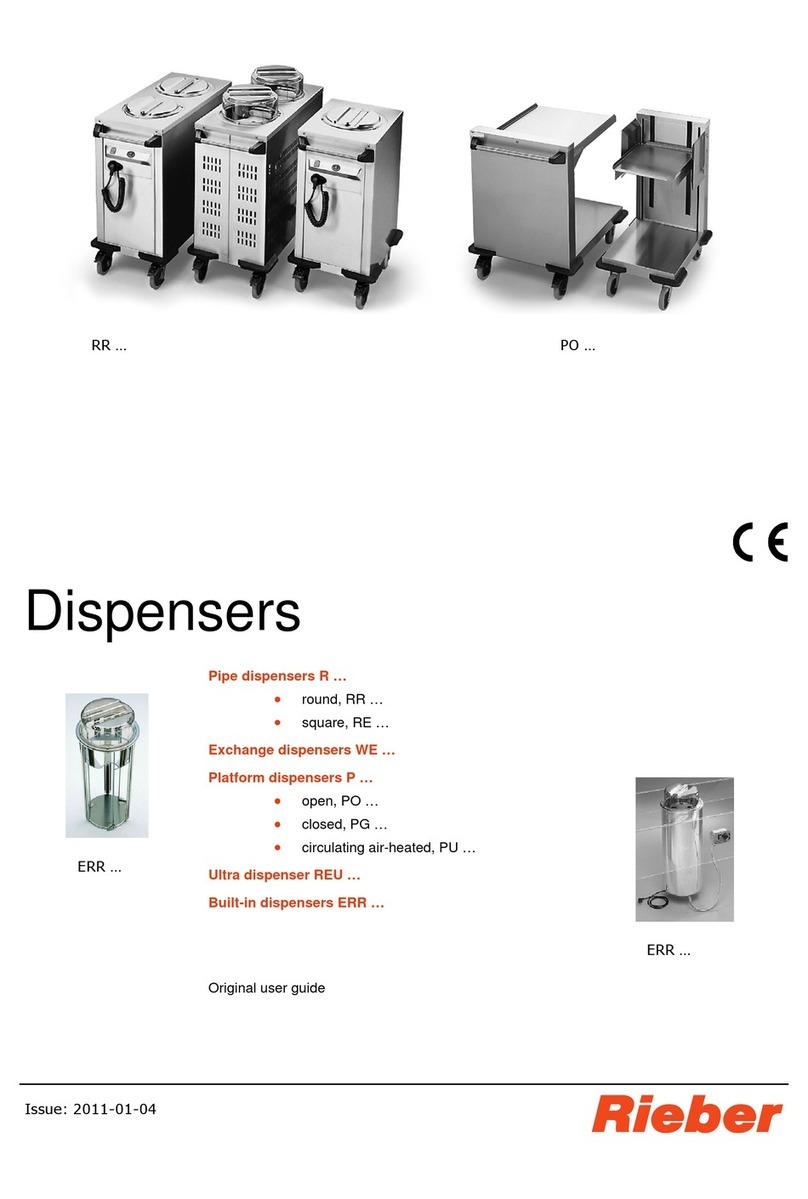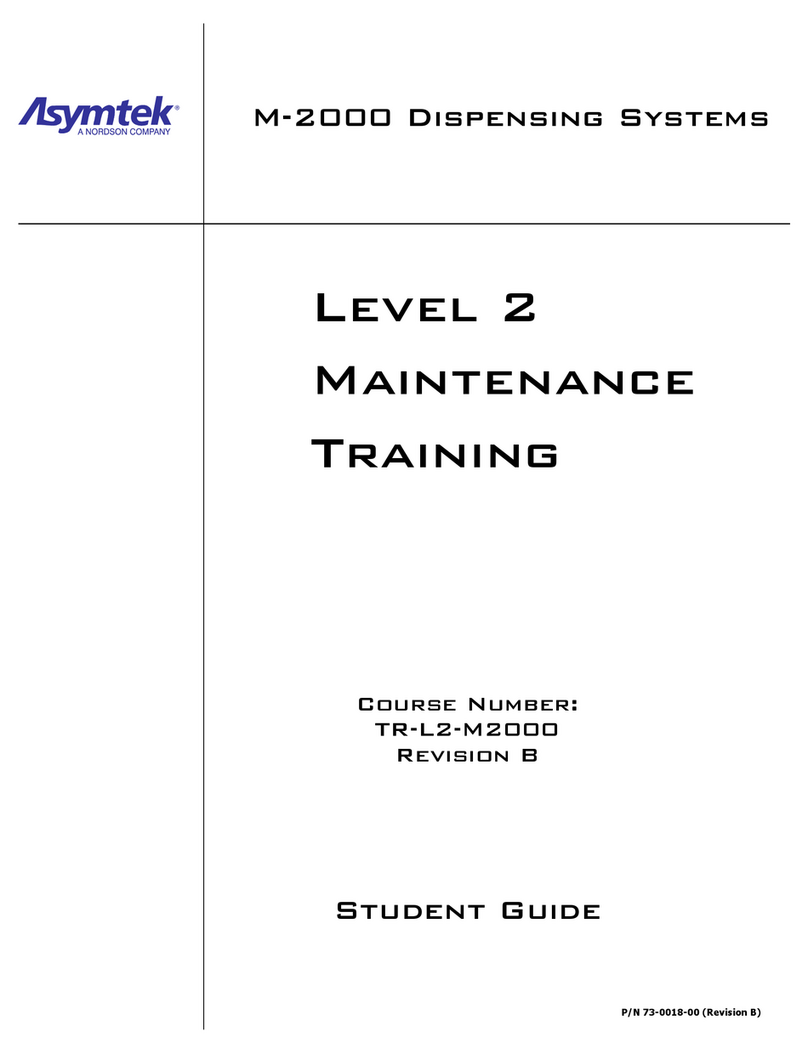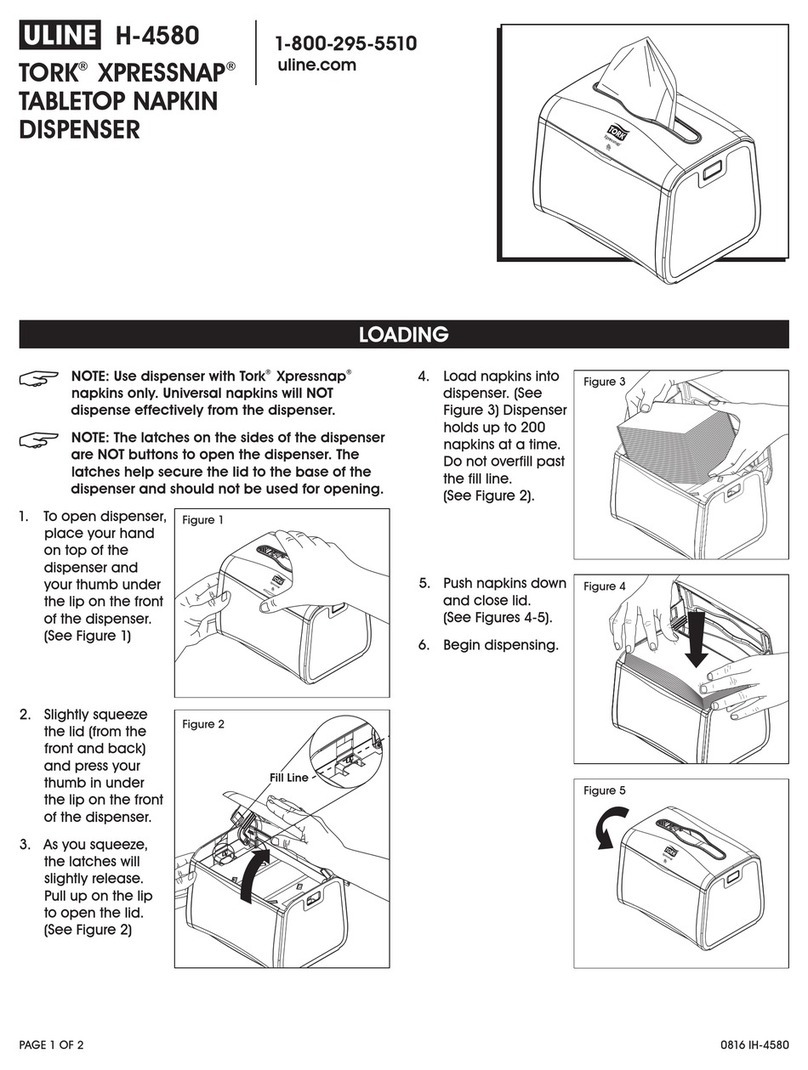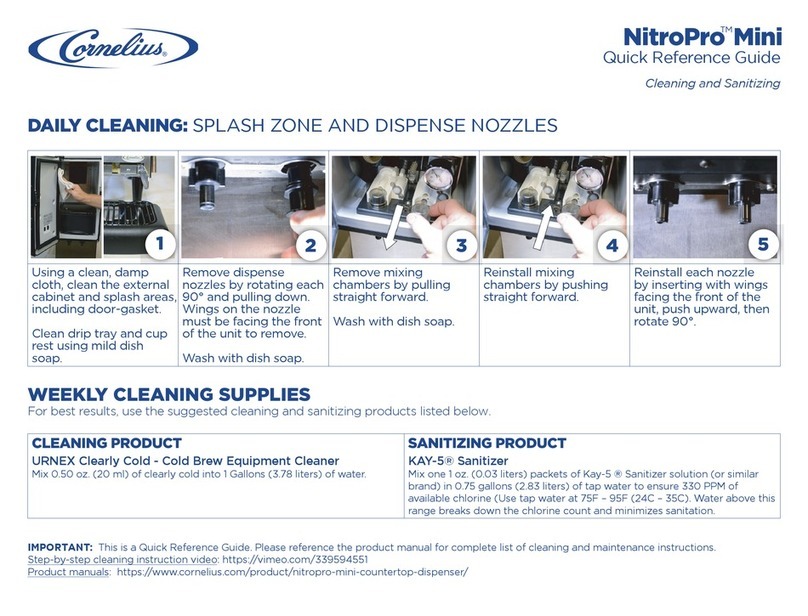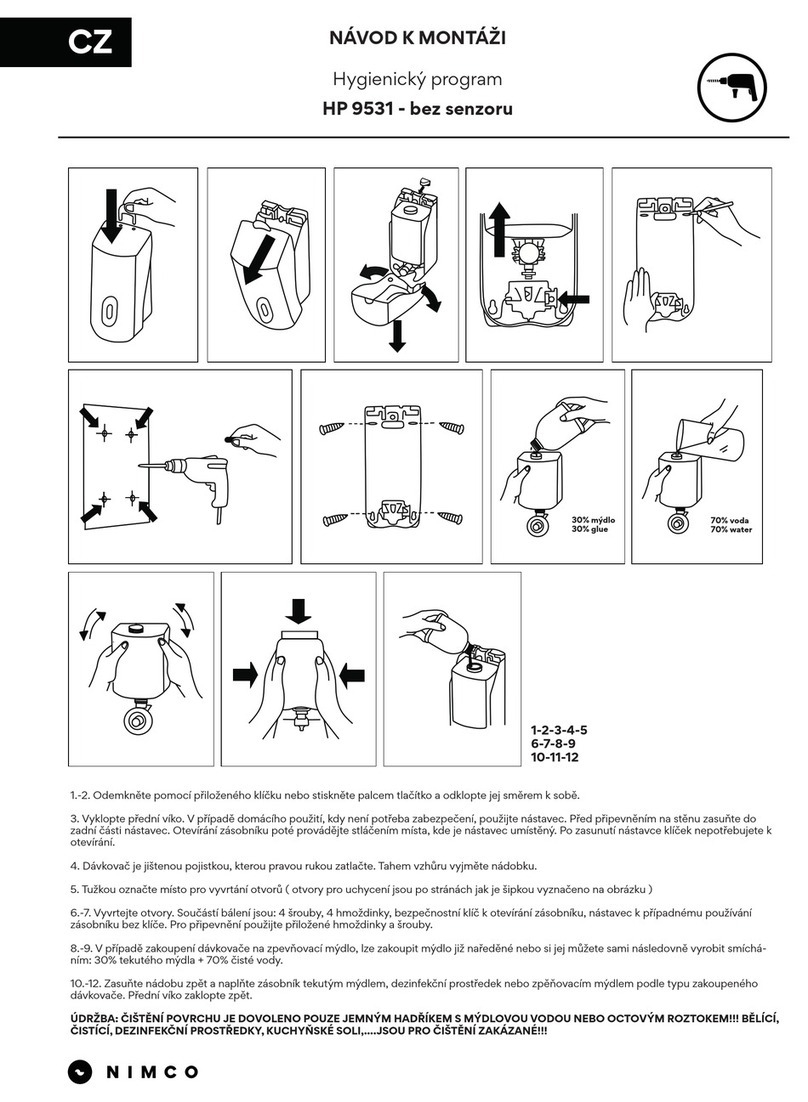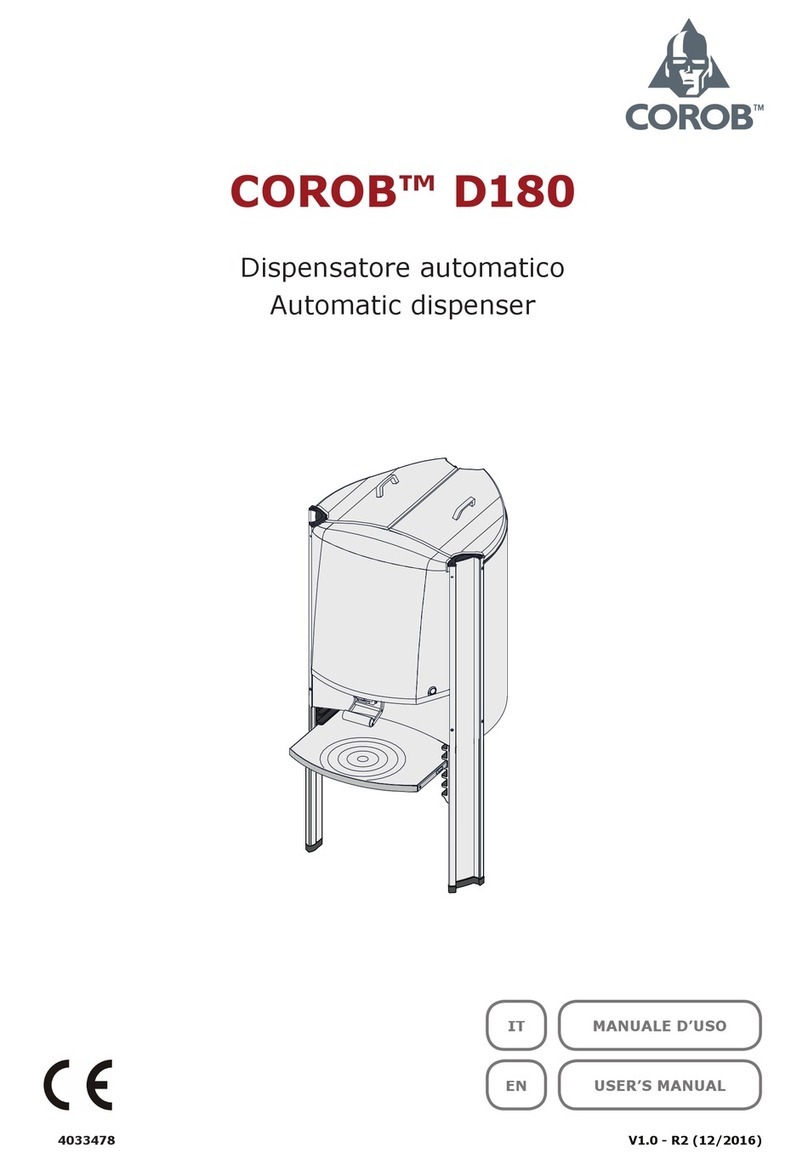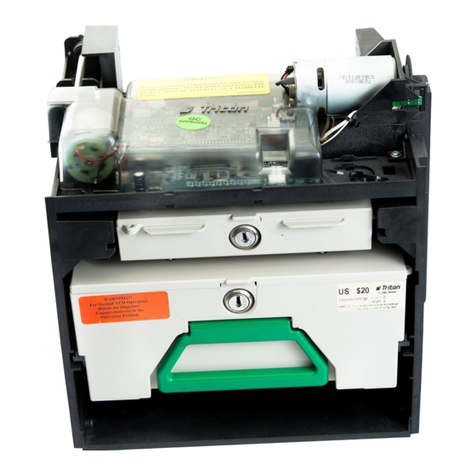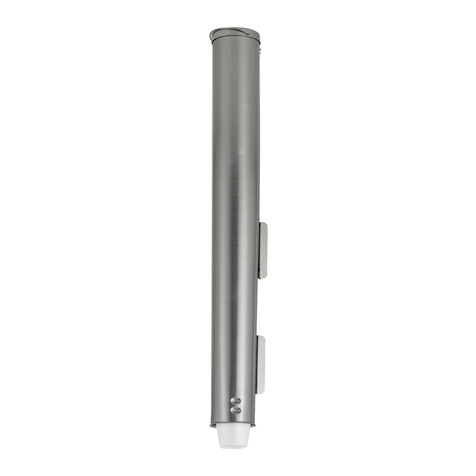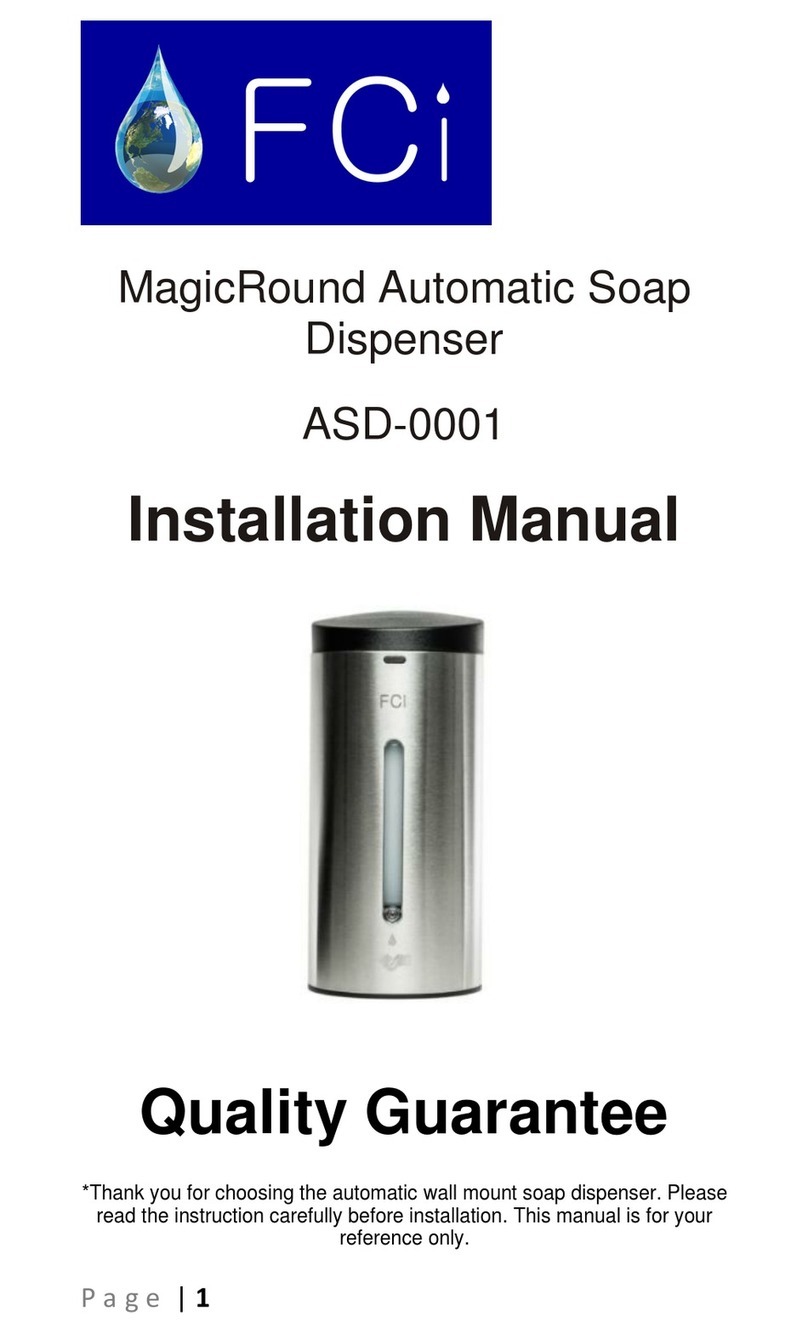Rieber RR Series User manual

Issue: 2012-03-22
Dispenser
Pipe dispenser R …
round, RR …
corner, RE …
Exchange dispenser WE …
Platform dispenser P …
open, PO …
closed, PG …
circulating air-heated, PU …
Ultra dispenser REU …
Built-in platform dispenser ERR …
Translation of the Original user guide
RR … PO …
ERR …
ERR …

Inhaltsverzeichnis
2 Rieber GmbH & Co. KG
Rieber Professional.Our solutions guarantee high quality, safety and, above all,
excellent energy efficiency and cost effectiveness.
Contents
1Revision index.................................................................................................................................................3
2Important information.....................................................................................................................................3
2.1 Use of this guide................................................................................................................................................3
2.2 Representation conventions in the text ..............................................................................................................4
2.3 Structure of safety instructions...........................................................................................................................4
3Description of appliance.................................................................................................................................5
3.1 Designation of parts using an example illustration .............................................................................................5
3.2 Product information............................................................................................................................................5
3.3 Accessories and their use..................................................................................................................................6
4Purpose............................................................................................................................................................6
4.1 Intended use of dispensers, general ..................................................................................................................6
4.2 Intended use of pipe dispensers R … ...............................................................................................................7
4.3 Intended use of exchange dispensers WE … ....................................................................................................8
4.4 Intended use of platform dispensers PO …........................................................................................................9
4.5 Intended use of ultra dispensers REU ….........................................................................................................11
4.6 Intended use of built-in dispensers ERR …......................................................................................................11
5General safety instructions ..........................................................................................................................12
5.1 General behaviour ...........................................................................................................................................12
5.2 On use of electrical appliances........................................................................................................................12
5.3 Operator's obligations......................................................................................................................................13
5.4 Personnel qualification.....................................................................................................................................14
5.5 Provide protective equipment for personnel.....................................................................................................14
5.6 Appliance-specific safety instructions...............................................................................................................14
5.7 Information about regulations to be followed....................................................................................................16
5.8 Instructions on behaviour in an emergency......................................................................................................16
6Before first use..............................................................................................................................................17
6.1 Transport .........................................................................................................................................................17
6.2 Commissioning ................................................................................................................................................17
7Adjustment of the dispenser to the crockery used....................................................................................18
7.1 Pipe dispenser R ….........................................................................................................................................18
7.2 Exchange dispenser WE … .............................................................................................................................20
7.3 Platform dispenser PO … ................................................................................................................................22
7.4 Ultra dispenser REU …....................................................................................................................................23
8Information on using the appliance.............................................................................................................24
8.1 Use the appliance only for its intended use......................................................................................................24
8.2 Operation.........................................................................................................................................................25
9Cleaning, maintenance and care..................................................................................................................26
10 Fault - What now?..........................................................................................................................................28
11 Warranty and liability....................................................................................................................................30
12 Excerpt from the EC Declaration of Conformity.........................................................................................31
13 Address of manufacturer..............................................................................................................................32

Revision index
Rieber GmbH & Co. KG 3
1 Revision index
Revision Change
2011-01-04 First issue
2012-03-22 Safety instructions before use, pages 19 and 21, page 31
2 Important information
2.1 Use of this guide
This guide contains important information about how you can use the appliance safely and correctly.
IMPORTANT
Protect yourself against potential hazards and prevent damage to your appliance.
►It is essential that you read the user guide before using the product for the first time.
►Keep the guide in a safe place and pass it on to any future user.
Our customers often express the wish to have one compact guide instead of a number of different
guides for these product variants, which have similar functions.
If there are any deficits from your point of view, please do not hesitate to let us know. With your help,
we will try to get even better.
Space for your notes:

Important information
4 Rieber GmbH & Co. KG
2.2 Representation conventions in the text
. . . Highlighting . . . , text to be highlighted
Listings are represented in this way.
Instructions on certain actions are represented in this way.
See ‘. . . ’ , cross-references are represented in this way.
Notes
NOTE
indicates potential damage to property without any personal injury.
Failure to follow these instructions may cause damage to property.
User tip
►Useful information or tip
2.3 Structure of safety instructions
The signal words DANGER - WARNING - CAUTION classify the degree of risk of bodily injury in an actual
situation. You can avoid injury by complying with the behavioural rules provided.
The warning triangle symbol indicates a "General Danger".
DANGER!
indicates imminent danger.
Failure to follow these warning instructions will result in serious bodily
injury or even death.
WARNING!
indicates a potentially hazardous situation.
Failure to follow these warning instructions may cause serious bodily
injury or even death.
CAUTION!
indicates a potentially harmful situation.
Failure to follow these warnings may cause minor bodily injury.

Description of appliance
Rieber GmbH & Co. KG 5
3 Description of appliance
This section provides useful information about the installation and operation of this appliance.
3.1 Designation of parts using an example illustration
In the following, the parts which are important for understanding the subsequent sections are identified.
1 Handle for pushing
2 Lid
3 Housing
4 Rocker switch with green indicator
5 Power regulator
6 Holder for the electrical connecting plug
7 Corner bumper
8 Ventilation slot
9 Caster with parking brake
9 Type plate
3.2 Product information
Chromium-nickel steel housing. Adjustment of uniform serving height by attaching and unhooking the
tension springs. 4 corner bumpers. Galvanised casters in accordance with DIN 18867, Part 8. Wheel
diameter 125 mm. 2 swivel casters and 2 swivel casters with brake, antistatic tyres.
Electrical unit is equipped with pull-out spiral cable 2.5 m with earthed connector and dummy socket
outlet, rocker switch with green indicator as ON/OFF switch, thermostat controller (continuous control),
1N AC 230V 50/60Hz. Ambient conditions +5°C to +40°C. Carcass with double-wall insulation.
R 134a refrigerant for cooling unit. Emitted sound pressure level closed 52.0 dB, emitted sound
pressure level open 61.5 dB.
Protection class IPX5 in accordance with DIN EN 60529 (jet-proof, nozzle, from any angle).
21 3
9 87
6
4
5
10

Purpose
6 Rieber GmbH & Co. KG
3.3 Accessories and their use
See website http://www.rieber.de
4 Purpose
This chapter describes the intended use and contains warnings against misuse, for your safety.
4.1 Intended use of dispensers, general
Generally, the following are intended uses for the product:
For mobile meal services in catering, hotels and restaurants; also for managed care
facilities and schools.
For keeping stacked parts neutral, cold or warm.
For stacking and dispensing stacked parts.
WARNING! Only remove parts at serving height. Jammed parts may generate high
forces which may discharge suddenly. Stacked parts must be centred and guided.
WARNING! To avoid injuries such as shearing and crushing due to reaching into
the inside of the unit or touching hot surfaces, use of the appliance in public/for self-
service should only be allowed under constant supervision.
WARNING! Wear personal protective equipment such as protective gloves, which
will prevent you from burning your arms or hands on hot parts, such as plates, meal
trays, etc.
For use by instructed persons only.
Prevent any potential misuse in advance:
WARNING! Never operate the appliance unsupervised.
ATTENTION! Baskets made of plastic are not suitable for heated crockery
dispensers.
Not intended for private use at home.
Do not lean against or sit on the appliance.
Keep any combustible or explosive fluids away from heated appliances, to prevent
the risk of fire or explosion.
Heated units may only be used for heating crockery. Do not use to heat up a room.
Do not use this appliance with poor floor conditions.
▌We are not able to rule out the possibility of marks appearing on the floor due to
friction with casters or the formation of scratches due to split cracks in the
casters, for example.
▌We are not able to rule out the possibility that the casters may be damaged or
become unusable due to swelling or sharp edges on the floor.
This appliance may only be moved manually, machine-supported moving is not
permitted.

Purpose
Rieber GmbH & Co. KG 7
4.2 Intended use of pipe dispensers R …
Generally, the following are intended uses for the product:
For stacking identical stackable plates.
Plates, bowls or cups can be stacked.
Carrying capacity per pipe maximum 75 kg
4.2.1 Pipe dispenser, round RR … ist bestimmt für runde Teile
Type designation:
R R ―Pipe dispenser
R R ―… round
R R V ―1 … with 1x adjustable pipe, unheated
R R V ―… with adjustable pipe.
Desired plate diameter can be fixed with 3 adjusting rods.
R R ―H … heated pool, static heating
R R ―U … heated pool, circulating air heating
R R ―1 … number of pipes
R R ―L … version with ventilation slots.
For pre-cooling plates etc. in refrigerated and deep-
freeze rooms
For RRV 190-280: from Ø 190 mm to Ø 280 mm.
For RRV 230-320: from Ø 230 mm to Ø 320 mm.
RRV - H RRV – L2 RRV – H1

Purpose
8 Rieber GmbH & Co. KG
4.2.2 Pipe dispenser, square RE … is intended for square parts
Type designation
R Pipe dispenser
R E … square
R H … heated pool, static heating
R U ―… heated pool, circulating air heating
R 2 … number of pipes
4.3 Intended use of exchange dispensers WE …
Generally, the following are intended uses for the product:
6 exchange rods can be distributed across 18 holes. Adaptable for crockery of
different sizes.
Carrying capacity maximum 150 kg
REH - 2
WE-H WE-Q 1/1

Purpose
Rieber GmbH & Co. KG 9
Type designation:
WE Exchange dispenser
WE ―H … heated pool, static heating
WE ―U … heated pool, circulating air heating
WE ―Q 1/1 … square, single appliance
For WE-H-750: special design with extremely reduced length for flush installation in niches, push
handle with impact protection, 2 corner bumpers
4.4 Intended use of platform dispensers PO …
Generally, the following are intended uses for the product:
For stacking and dispensing trays or crockery baskets.
Carrying capacity maximum 200 kg
4.4.1 Platform dispensers, open PO …
Type designation:
PO Platform dispenser, open
PO ―SV … Distribution of food
PO ―GN … Gastronorm
PO ―Q … square
PO ―SV1/1 Special version with lateral tray guide for tray destacking
PO ―TA1/1 Special version with lateral tray guide for tray destacking

Purpose
10 Rieber GmbH & Co. KG
4.4.2 Platform dispenser closed and refrigerated PG …
Type designation:
PG Platform dispenser, closed
PG ―GN … Gastronorm
PG ―SV … Distribution of food
PG ―Q … square
PG ―4S … for 4 cloches per level
PG ―6S … for 6 cloches per level
PK ―Q1/1 … air cooled
4.4.3 Platform dispenser, circulating air-heated
and meal tray dispenser, circulating air-heated PU …
Type designation:
PU Platform dispenser, circulating air-heated
PU ―GN … Gastronorm
PU ―SV … Distribution of food
PU ―Q … square
PU ―M … stainless steel hinged lid;
only suitable for stainless steel baskets
PU-M

Purpose
Rieber GmbH & Co. KG 11
4.5 Intended use of ultra dispensers REU …
Generally, the following are intended uses for the product:
For stacking, dispensing and heating heat/ultra bowls from Rieber.
Type designation:
REU Ultra dispenser
REU ―P … … for heating heat/ultra bowls
4.6 Intended use of built-in dispensers ERR …
Generally, the following are intended uses for the product:
Heated or unheated pipe dispensers are designed for stationary installation in a
counter or serving system.
Type designation:
ERR Built-in platform dispenser
ERR ―V … adjustable pipes, unheated
ERR ―V ―H … adjustable pipes, static, heated
REU-P
ERR-V-H ERR-V

General safety instructions
12 Rieber GmbH & Co. KG
5 General safety instructions
This section covers residual risks and hazards associated with the intended use of the appliance. We have
provided a list of all generally valid safety instructions which must be followed.
In the following section, safety information relating to a particular operation or situation is placed before the
appropriate operation step or description of the situation.
5.1 General behaviour
This appliance meets the current state of the art and complies with all acknowledged technical safety-
related regulations. Nevertheless hazards may still arise.
Only use this appliance when it is in fault-free condition and according to the instructions in this
user guide.
During all phases of the appliance's life please ensure that the appliance is safely integrated into
its environment.
Do not make any conversions or modifications to the appliance.
5.2 On use of electrical appliances
Safety instructions according to EN 60745-1:
Work area
Keep your work area clean and tidy. A messy or unlit work area can cause accidents.
Keep children and other persons at a distance when using the product.
Electrical safety
The plug on the unit must fit in the socket. Do not modify the plug in any way. Never use
an adapter in combination with earthed appliances. Using an unmodified plug and a
suitable socket will reduce the risk of an electric shock.
Avoid bodily contact with earthed surfaces such as pipes, heating units, cookers and
refrigerators. The risk of an electric shock is greater when your body is earthed.
Keep the appliance away from rain or damp. Allowing water to get into an electric
appliance will increase the risk of electric shock.
Do not misuse the cable by using it to remove the plug from the socket. Always remove
whilst holding onto the plug. Keep the cable away from heat, oil, sharp edges or the
moving parts of other appliances. Using damaged or tangled cables increases the risk of
electric shock.
When working with an appliance outdoors, only use extension cables which are permitted
for outdoor use. Using an extension cable suitable for outdoor use reduces the risk of
electric shock.
Potential risk of fire due to heat build-up. Unwind the cable from the spool to prevent any
heat build-up or cable fire. The coupling must have splash protection, must be made of
rubber or be rubber-coated. The cable cross-section must be at least 1.5 mm2.
Safety guidelines for persons
Be attentive and pay attention to what you are doing, act rationally when working with an
electrical appliance. Do not use the appliance when tired or under the influence of drugs,
alcohol or medication.
Just one moment of inattention whilst using the appliance can result in serious injury.
Make sure the appliance cannot be switched on unintentionally. Double check that the
main switch is in the "OFF" position before inserting the plug in the socket. Connecting
the appliance to the power supply while it is switched on can cause an accident.

General safety instructions
Rieber GmbH & Co. KG 13
Careful handling and use of electrical appliances
Never use an electrical appliance with a faulty switch. An electrical appliance which can
no longer be switched on or off is dangerous and must be repaired.
Keep unused electrical appliances in places where children are not able to reach them.
Do not allow the appliance to be used by persons who are not familiar with it or persons
who are not familiar with this user guide. Electrical appliances are dangerous when in the
hands of inexperienced persons.
Handle the appliance carefully. Make sure all moving parts of the appliance work
perfectly and are not jammed, also check whether any parts are broken or damaged to
the extent that operation of the appliance is impaired. Have any damaged parts repaired
before using the appliance. Many accidents are caused by poorly-maintained electrical
appliances.
Use electrical appliances, accessories etc. in accordance with these guidelines and in a
manner that is specified for this particular appliance type. When using the appliance,
please take into account the working conditions and the work being carried out. Using
electrical appliances for other uses than that intended can lead to hazardous situations.
Service
Only have the device repaired by qualified and authorised staff. Only use original spare
parts. In this way you can ensure that the appliance remains safe.
5.3 Operator's obligations
Operator
The operator is the person who operates the appliance for commercial or economic purposes either
himself/herself or lets others use it and bears the legal appliance responsibility for protection of the
user, staff or any third parties during operation.
Operator's duties
The appliance is used in commercial applications. For this reason, the operator of the appliance must
meet all legal duties relating to work safety.
In addition to the safety instructions in this guide, the safety, accident prevention and environmental
protection regulation applying to the application of the appliance must be complied with.
In particular, the following shall apply:
The operator must be familiar with the applicable work safety regulations and
identify, by carrying out a risk analysis, any additional hazards which are due to the
place where the appliance is used. These hazards must be addressed in the form of
operating instructions governing the operation of the appliance.
During the whole service lift of the appliance, the operator must verify if the
operator's operating instructions reflect the current versions of the applicable
regulations. If necessary, the operator must update the operating instructions
accordingly.
The operator must define and assign the responsibilities for installation, operation,
repair, maintenance and cleaning clearly.
The operator must make sure that all personnel working with the appliance have
read and understood this guide. In addition, the operator must train the personnel
and inform them of the hazards involved at regular intervals.
The operator must provide the personnel with the necessary protective equipment
and make sure that they wear it.

General safety instructions
14 Rieber GmbH & Co. KG
In addition, the operator must ensure that the appliance is always in a perfect technical condition. For
this reason, the following shall apply:
The operator must ensure that the maintenance intervals defined in this guide are
obeyed.
The operator must have all safety equipment be checked regularly for completeness
and proper function.
The operator must ensure that the required media connections are available.
The operator must ensure that all safety-relevant measures required on site are
taken.
5.4 Personnel qualification
Safe operation requires certain technical skills and personal qualification of each person.
The responsibility for organization lies with the ‘Designated Representative’
(operator).
According to EN 50110-1, the Designated Representative is a 'person assigned the
direct responsibility for the performance of the work. If necessary, this responsibility
can be assigned partly to other persons. [...] The designated representative must
instruct all persons involved in the work on all hazards which may not be obvious for
them’.
The work may only be performed by ‘instructed persons’ who have been trained
accordingly. Training, instructions must be repeated, proper understanding must be
verified (ideally by way of an appropriate test).
Only ‘Qualified Staff’ is allowed to carry out repair work.
IEC 60204-1 defines qualified personnel as "persons who, on account of their
training and relevant experience are in the position to recognise risks and avoid
potentially dangerous situations."
Electrical work may only be carried out by trained and experienced electricians.
Electro-technically instructed persons may only work under the supervision of a
qualified electrician.
5.5 Provide protective equipment for personnel
Ensure that the personnel wears the personal protective equipment appropriate to the relevant
situation.
Wear sturdy shoes to avoid injury.
Wear safety gloves to avoid burns at hands and arms.
5.6 Appliance-specific safety instructions
This chapter describes general, appliance-specific safety instructions. In the following section, additional safety
information relating to a particular operation or situation is placed before the appropriate operation step or
description of the situation.
5.6.1 Safety and monitoring devices
The appliance features a safety cut-out. The appliance switches itself off
automatically in the event of a fault to the control system.
To increase your safety we recommend you install a earth leakage circuit breaker
with a tripping current of 30 mA upstream to the appliance.

General safety instructions
Rieber GmbH & Co. KG 15
5.6.2 Hazards due to mechanically jammed parts shooting up
WARNING!
There are many different risks of injury in the area of the dispenser platform of pipe
dispensers R …, exchange dispensers WE …, built-in dispensers E … . The platform
may jam if crockery or broken pieces get caught between the springs or in the moving
parts of the platform.
When the jam is cleared, there is a risk of the platform suddenly shooting up as a result of
spring tension and ejecting crockery or damaged parts of the platform.
Platforms or crockery shooting up can cause crushing, shearing or compression of arms,
hands or other parts of the body inside the appliance.
►Secure a jammed platform against accidental shooting up, until all blocking crockery
parts have been removed. Use a sturdy bar or rod to do this. If possible, unhook or
cut through individual springs to reduce the overall spring tension.
►Finally remove the securing rod or bar, taking special care due to the preloaded
parts.
Also see ‘Adjustment of the dispenser to the crockery used’, page 17
5.6.3 Risk of burns due to hot surfaces
WARNING!
One can burn one's hands and arms on the hot surfaces around the heating and its
environment.
►Where possible wear protective gloves.
►Keep combustible materials away from the product.
►Keep unauthorised persons away from the appliance.
5.6.4 Dangers during transport and due to unstable position
WARNING! Do not pull the appliance, only push it. This ensures good visibility and direct access
to the casters with brakes.
Keep the door closed during transport and push the appliance by the handle. Wear sturdy shoes to
avoid injuries.
WARNING! Avoid unintentional moving of the appliance and the resulting hazards. Prevent the
appliance from accidentally rolling away using the two parking brakes. Only park the appliance on
flat surfaces.
ATTENTION! Note the permissible step height, maximum 4 mm, otherwise the casters might be
damaged.
Remove accessories and transport them separately.

General safety instructions
16 Rieber GmbH & Co. KG
5.6.5 Comply with the applicable electrical regulations
WARNING!
Danger of electric shock. Dangerous electrical voltage. The total connected load of
electrical appliances might exceed the locally permissible connected load.
►Have electrical work carried out by the manufacturer, its customer service or a
qualified electrician only.
►Only connect the appliance via a residual current operated device (RCD).
Connect the appliance to the ground conductor.
►Peak loads can occur, for example, when several appliances are turned on/off
simultaneously. Material damage, including cable fire, is possible. Comply with the
locally permissible connected load. Avoid switching a large number of appliances
on/off at the same time.
Also see ‘On use of electrical appliances’, page 12
5.7 Information about regulations to be followed
Alongside this user guide there are a range of health and safety and other regulations that are relevant
for the operation of this cooking station; these include HACCP food hygiene regulations for example.
5.8 Instructions on behaviour in an emergency
In an emergency, always turn the appliance off immediately and unplug the mains connector.
First aid in case of crushing, burns or electric shock:
Inform yourself on this before commissioning the appliance.
Store the emergency equipment, including the relevant instructions, at a readily accessible place
near the place of use. Make yourself familiar with the instructions.
User tip
►Inform yourself in detail taking the company-internal instructions as a reference.
►We recommend that half-yearly emergency training sessions should be carried out.

Before first use
Rieber GmbH & Co. KG 17
6 Before first use
This chapter describes the measures to be taken before use.
6.1 Transport
6.1.1 Check/handle any transport damage
Immediately after delivery, visually check the appliance for any transport damage.
Document any potential transport damage on the consignment note in the presence of the haulage
contractor, and have the damage confirmed by the haulage contractor (with signature).
Decide if you wish to keep the appliance and claim the defect using the consignment note, or if
you wish to reject the appliance.
▌By following this procedure you will contribute to proper claim settlement.
6.1.2 Unpacking
Open the transport packaging at the positions provided for this purpose. Do not tear or cut.
Remove any packaging remnants.
6.1.3 Scope of supply
Inspect the scope of supply.
6.1.4 Dispose of packaging material
Dispose of packaging material in an environmentally compatible way.
6.2 Commissioning
Preconditions
The appliance has no defects or visible damage.
The appliance has room temperature and is dry.
NOTE
Protective foils or heat-sensitive objects at/in the appliance might damage the appliance
during heating.
►Ensure that there are no protective foils in the inside and on the outside of the
appliance.
Clean the appliance
See chapter ‘Cleaning, maintenance and care’, page 26

Adjustment of the dispenser to the crockery used
18 Rieber GmbH & Co. KG
7 Adjustment of the dispenser to the crockery used
7.1 Pipe dispenser R …
1 Adjustable rod
2 Spring clip
3 Dispenser pipe
4 Base hole
Adjust the pipe dispenser, round RR … to the crockery diameter
Lock the dispenser using the parking brake and unplug the mains connector.
Remove dispenser pipe (3).
Loosen spring clip (2) with tool. Raise adjusting rod (1) and swivel if required.
Fix adjusting rods (1) through the base hole (4). Fix all adjusting rods using the same base hole.
▌There should be a continuous gap of 2 to 5 mm between adjusting rods (1) and
plates, in order to compensate for crockery tolerances.
After adjustment lock all spring clips (2) again, using the tool.
1
2
3
4

Adjustment of the dispenser to the crockery used
Rieber GmbH & Co. KG 19
Adjusting the pipes to the weight of the crockery
WARNING!
Risk of injury if pipes are adjusted incorrectly. When plates are removed from a jammed
pipe, the other plates can be ejected.
Incorrectly installed springs can loosen during operation.
►Carry out the setup work correctly.
►The springs have an open eye on one side and a closed eye on the other. When
installing the springs, ensure that the open side always faces up.
See illustration at beginning
WARNING!
Risk of injury if dispensing level is below lower edge of housing. Fingers and hands may be
sheared or crushed.
►Ensure that the dispensing level is always above the lower edge of the housing.
Place the empty pipe on a level surface.
Insert approx. 20 plates into the pipe.
▌The spring adjustment is optimal if approx. 3 to 6 plates project over the edge of
the pipe.
If more plates project, remove the springs again.
If too few plates project, install springs. .

Adjustment of the dispenser to the crockery used
20 Rieber GmbH & Co. KG
After adjustment of the pipes, reinstall them in the dispenser carefully.
7.2 Exchange dispenser WE …
1 Exchange rod
2 Holes
3 Dispenser pipe
The dispenser platform can be divided. 6 exchange rods can be inserted in 18 possible holes. The
holes are distributed in accordance with the most common plate diameters (200, 220, 240, 260,
280 mm).
Adjustment of exchange dispenser to crockery.
Lock the dispenser using the parking brake and unplug the mains connector.
Remove dispenser pipes (3).
Fix exchange rods (1).
▌There should be a continuous gap of 2 to 5 mm between exchange rods and
plates, in order to compensate for crockery tolerances.
After adjustment lock all spring clips again, using the tool.
1
2
3
Other manuals for RR Series
1
This manual suits for next models
42
Table of contents
Other Rieber Dispenser manuals
Popular Dispenser manuals by other brands

Curtis
Curtis TCN Instructions and parts list
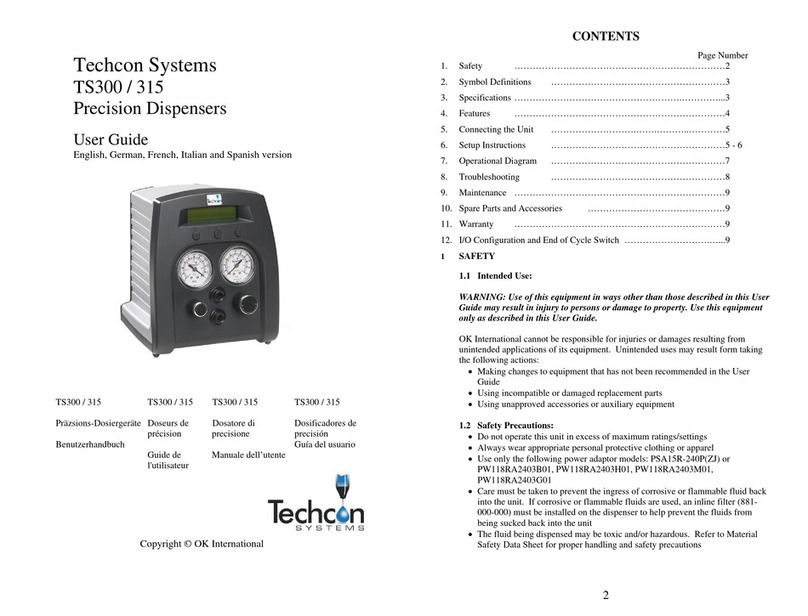
TECHCON SYSTEMS
TECHCON SYSTEMS TS300 user guide
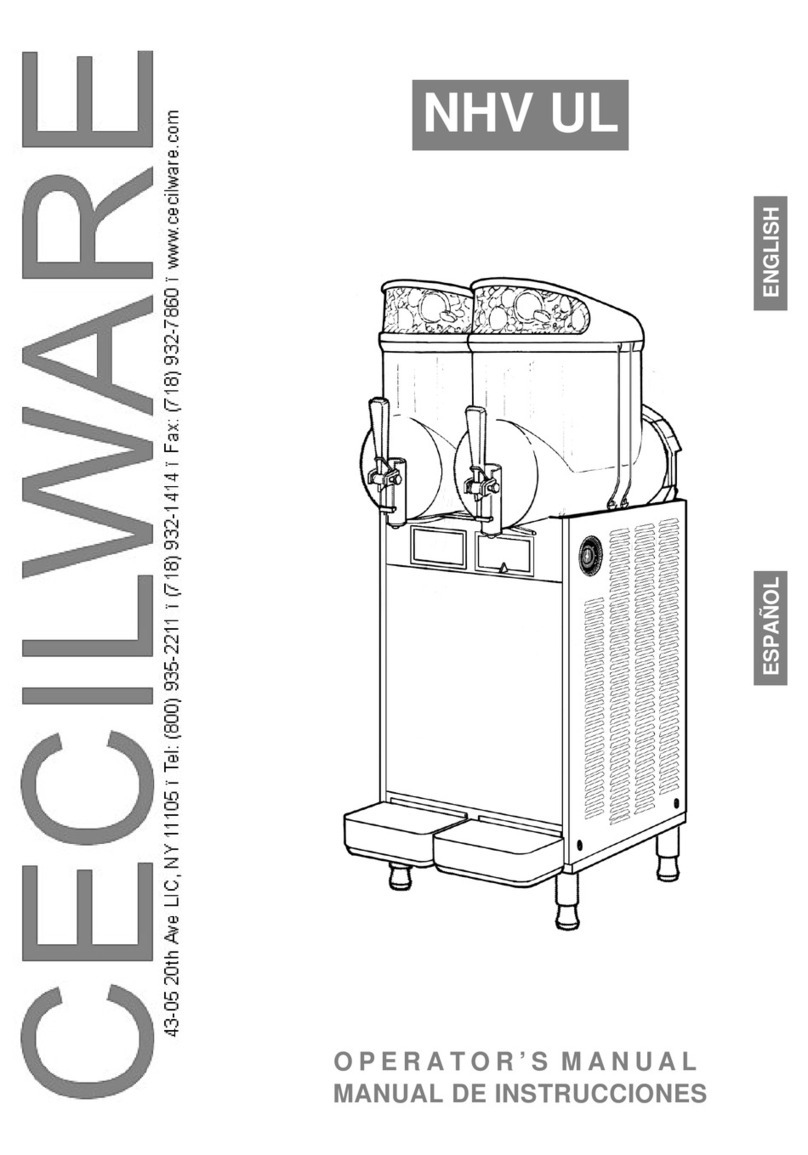
Cecilware
Cecilware NHV-2-UL Operator's manual
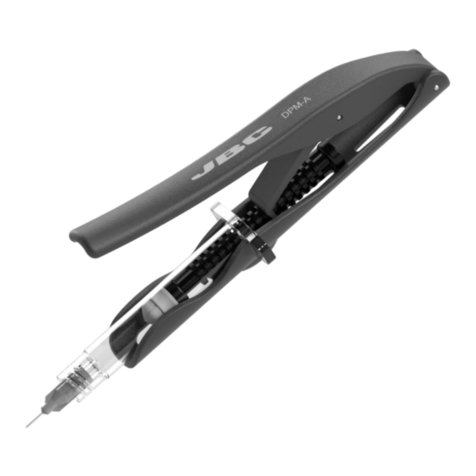
jbc
jbc DPM-A instruction manual
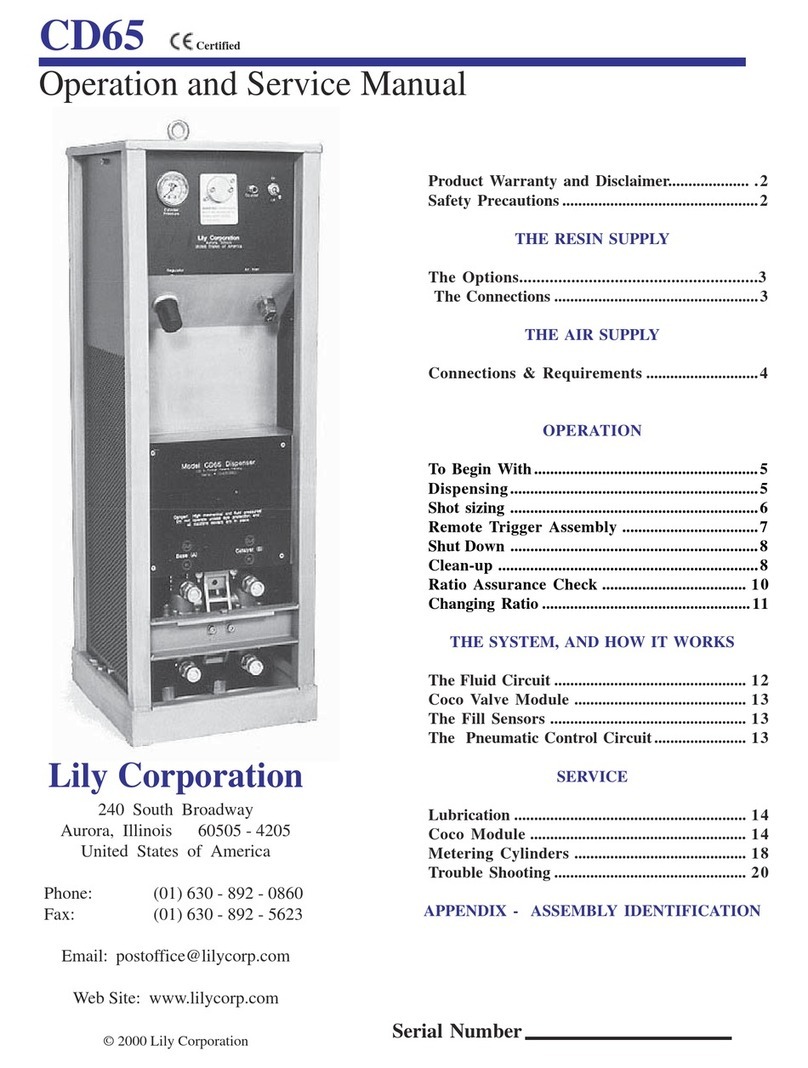
Lily Corporation
Lily Corporation CD65 Operation and service manual
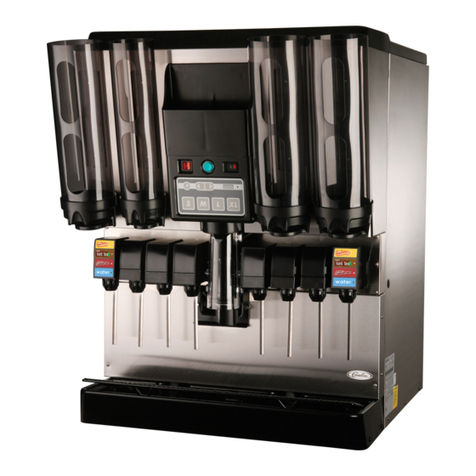
Cornelius
Cornelius IDC 255 PROGATE DRIVE THRU UNIT Operator's manual
